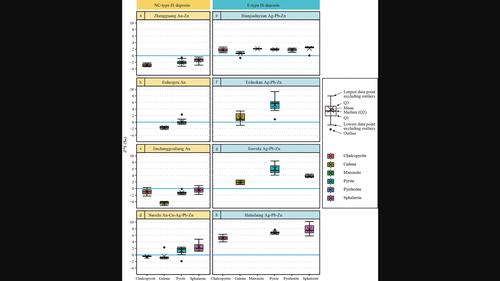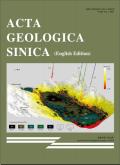用硫同位素揭示成矿流体氧化还原演化——以正光中硫化浅成热液金锌矿为例
IF 3.5
3区 地球科学
Q1 GEOSCIENCES, MULTIDISCIPLINARY
引用次数: 0
摘要
氧逸度(fO2)是整个岩浆热液成矿过程中的一个关键强度变量。由于缺乏适当的流体fO2测定方法,中硫化浅成热液成矿流体的氧化还原状态及其在不同阶段之间的变化很少被破译。本文报道了郑光早奥陶世富金中硫化(IS)浅成热液矿床3期(ⅰ、ⅱ、ⅲ期)硫化物的δ34S,以揭示成矿流体的氧化还原演化。从ⅰ期黄铁矿(py1,平均-2.6‰)到py2期(平均-1.9‰),再到py3期(平均-0.2‰),δ34S值逐渐增大,表明成矿流体氧逸度降低。对中国东北地区富金和富银两类IS矿床的硫化物δ34S值进行了整理,结果表明,富金IS矿床的硫化物δ34S值比富银IS Ag - Pb - Zn矿床的硫化物δ34S值轻,表明前者的成矿流体氧化程度高于后者。我们强调,下第三系硫化物的硫同位素组成是识别浅成低温热液矿床氧逸度波动的有效指标,并有可能用于区分is矿床的亚型。本文章由计算机程序翻译,如有差异,请以英文原文为准。

Unveil the Redox Evolution of Ore‐forming Fluids using Sulfur Isotope: A Case Study of the Zhengguang Intermediate Sulfidation Epithermal Au‐Zn Deposit, NE China
Oxygen fugacity (fO2) is a key intensity variable during the entire magmatic‐hydrothermal mineralization courses. The redox state and its variations between different stages of the ore‐forming fluids of intermediate sulfidation epithermal deposits are rarely deciphered due to the lack of appropriate approaches to determine fO2 of the fluids. Here, we reported the δ34S of the sulfides from three different stages (stage I, II, III) of Zhengguang, an Early Ordovician Au‐rich intermediate sulfidation (IS) epithermal deposit, to decipher the redox evolution of the ore‐forming fluids. The increasing δ34S values from stage I pyrite (py1, average –2.6‰) through py2 (average –1.9‰) to py3 (average –0.2‰) indicates a decrease of the oxygen fugacity of the ore‐forming fluids. A compilation of δ34S values of sulfides from two subtypes of IS deposits (Au‐rich and Ag‐rich) from NE China shows that the δ34S values of sulfides from Au‐rich IS deposits are systematically lighter than those of Ag‐rich IS Ag‐Pb‐Zn deposit, indicating the ore‐forming fluids of the former are more oxidized than the latter. We highlight that sulfur isotopic composition of hypogene sulfides is an efficacious proxy to fingerprint the oxygen fugacity fluctuations of epithermal deposits and could potentially be used to distinguish the subtypes of IS deposits.
求助全文
通过发布文献求助,成功后即可免费获取论文全文。
去求助
来源期刊

Acta Geologica Sinica ‐ English Edition
地学-地球科学综合
CiteScore
3.00
自引率
12.10%
发文量
3039
审稿时长
6 months
期刊介绍:
Acta Geologica Sinica mainly reports the latest and most important achievements in the theoretical and basic research in geological sciences, together with new technologies, in China. Papers published involve various aspects of research concerning geosciences and related disciplines, such as stratigraphy, palaeontology, origin and history of the Earth, structural geology, tectonics, mineralogy, petrology, geochemistry, geophysics, geology of mineral deposits, hydrogeology, engineering geology, environmental geology, regional geology and new theories and technologies of geological exploration.
 求助内容:
求助内容: 应助结果提醒方式:
应助结果提醒方式:


